Interannual and Seasonal Variability of CO2 Parameters in the Tropical Atlantic Ocean
Abstract
1. Introduction
2. Materials and Methods
2.1. Area of Study
2.2. Methods
3. Results
3.1. Time Series of CO2 Parameters
3.2. Mean State of Carbon Parameters
3.3. Seasonal Variability of FGCO2
3.4. Seasonal Variability of pCO2
3.5. Seasonal Variability of Total Alkalinity (ALK)
3.6. Seasonal Variability of Total Inorganic Carbon TCO2
3.7. Interannual Variability of CO2 Parameters and Climate Indices in the Tropical Atlantic Ocean
4. Discussion
5. Conclusions
Supplementary Materials
Author Contributions
Funding
Institutional Review Board Statement
Informed Consent Statement
Data Availability Statement
Acknowledgments
Conflicts of Interest
References
- Davila, X.; Gebbie, G.; Brakstad, A.; Lauvset, S.K.; McDonagh, E.L.; Schwinger, J.; Olsen, A. How Is the Ocean Anthropogenic Carbon Reservoir Filled? Glob. Biogeochem. Cycles 2022, 36, e2021GB007055. [Google Scholar] [CrossRef]
- Alexander, L.; Allen, S.; Bindoff, N.L.; Breon, F.-M. Climate change 2013: The physical science basis, in contribution of Working Group I (WGI) to the Fifth Assessment Report (AR5) of the Intergovernmental Panel on Climate Change (IPCC). In Climate Change 2013: The Physical Science Basis; Cambridge University Press: Cambridge, UK, 2013. [Google Scholar]
- Sabine, C.L.; Feely, R.A.; Gruber, N.; Key, R.M.; Lee, K.; Bullister, J.L.; Wanninkhof, R.; Wong, C.S.; Wallace, D.W.R.; Tilbrook, B.; et al. The Oceanic Sink for Anthropogenic CO2. Science 2004, 305, 367–371. [Google Scholar] [CrossRef] [PubMed]
- Lefèvre, N.; Diverrès, D.; Gallois, F. Origin of CO2 undersaturation in the western tropical Atlantic. Tellus B 2010, 62, 595–607. [Google Scholar] [CrossRef]
- Chikamoto, M.O.; DiNezio, P. Multi-Century Changes in the Ocean Carbon Cycle Controlled by the Tropical Oceans and the Southern Ocean. Glob. Biogeochem. Cycles 2021, 35, e2021GB007090. [Google Scholar] [CrossRef]
- Bonou, F.K.; Noriega, C.; Lefèvre, N.; Araujo, M. Distribution of CO2 parameters in the Western Tropical Atlantic Ocean. Dyn. Atmos. Oceans 2016, 73, 47–60. [Google Scholar] [CrossRef]
- Bonou, F.; Medeiros, C.; Noriega, C.; Araujo, M.; Hounsou-Gbo, A.; Lefèvre, N. A comparative study of total alkalinity and total inorganic carbon near tropical Atlantic coastal regions. J. Coast. Conserv. 2022, 26, 31. [Google Scholar] [CrossRef]
- Padin, X.A.; Gago, J.; Gilcoto, M.; Alvarez, M.; Pardo, P.C. Air-sea CO2 fluxes in the Atlantic as measured during the FICARAM cruises. Biogeosci. Discuss. 2010, 7, 1587–1606. Available online: www.biogeosciences-discuss.net/6/5589/2009/ (accessed on 23 November 2024). [CrossRef]
- Ibánhez, J.S.P.; Flores, M.; Lefèvre, N. Collapse of the tropical and subtropical North Atlantic CO2 sink in boreal spring of 2010. Sci. Rep. 2017, 7, srep41694. [Google Scholar] [CrossRef]
- Jiang, L.; Cai, W.; Wanninkhof, R.; Wang, Y.; Lüger, H. Air-sea CO2 fluxes on the U.S. South Atlantic Bight: Spatial and seasonal variability. J. Geophys. Res. Oceans 2008, 113, C07019. [Google Scholar] [CrossRef]
- Padin, X.A.; Vázquez-Rodríguez, M.; Castaño, M.; Velo, A.; Alonso-Pérez, F.; Gago, J.; Gilcoto, M.; Álvarez, M.; Pardo, P.C.; de la Paz, M.; et al. Air-Sea CO2 fluxes in the Atlantic as measured during boreal spring and autumn. Biogeosciences 2010, 7, 1587–1606. [Google Scholar] [CrossRef]
- Lefèvre, N.; Guillot, A.; Beaumont, L.; Danguy, T. Variability of fCO2 in the Eastern Tropical Atlantic from a moored buoy. J. Geophys. Res. Oceans 2008, 113, C01015. [Google Scholar] [CrossRef]
- Lefèvre, N.; Caniaux, G.; Janicot, S.; Gueye, A.K. Increased CO2 outgassing in February-May 2010 in the tropical Atlantic following the 2009 Pacific El Niño. J. Geophys. Res. Oceans 2013, 118, 1645–1657. [Google Scholar] [CrossRef]
- GFoltz, G.R.; McPhaden, M.J. Impact of Barrier Layer Thickness on SST in the Central Tropical North Atlantic. J. Clim. 2009, 22, 285. [Google Scholar] [CrossRef]
- Frankignoul, C.; Kestenare, E. Air–Sea Interactions in the Tropical Atlantic: A View Based on Lagged Rotated Maximum Covariance Analysis. J. Clim. 2005, 18, 3874–3890. [Google Scholar] [CrossRef]
- Brandt, P.; Alory, G.; Awo, F.M.; Dengler, M.; Djakouré, S.; Koungue, R.A.I.; Jouanno, J.; Körner, M.; Roch, M.; Rouault, M. Physical processes and biological productivity in the upwelling regions of the tropical Atlantic. Ocean Sci. 2023, 19, 581–601. [Google Scholar] [CrossRef]
- Landschützer, P.; Gruber, N.; Bakker, D.C.E.; Schuster, U. Recent variability of the global ocean carbon sink. Glob. Biogeochem. Cycles 2014, 28, 927–949. [Google Scholar] [CrossRef]
- Foltz, G.R.; Brandt, P.; Richter, I.; Rodríguez-Fonseca, B.; Hernandez, F.; Dengler, M.; Rodrigues, R.R.; Schmidt, J.O.; Yu, L.; Lefevre, N.; et al. The Tropical Atlantic Observing System. Front. Mar. Sci. 2019, 6, 206. [Google Scholar] [CrossRef]
- Bourlès, B.; Araujo, M.; McPhaden, M.J.; Brandt, P.; Foltz, G.R.; Lumpkin, R.; Giordani, H.; Hernandez, F.; Lefèvre, N.; Nobre, P.; et al. PIRATA: A Sustained Observing System for Tropical Atlantic Climate Research and Forecasting. Earth Space Sci. 2019, 6, 577–616. [Google Scholar] [CrossRef]
- GEBCO Bathymetric Compilation Group 2024. GEBCO_2024 Grid. British Oceanographic Data Centre. Available online: https://www.bodc.ac.uk/data/published_data_library/catalogue/10.5285/1c44ce99-0a0d-5f4f-e063-7086abc0ea0f (accessed on 15 September 2024).
- Chau, T.T.T.; Gehlen, M.; Chevallier, F. A seamless ensemble-based reconstruction of surface ocean pCO2 and air–sea CO2 fluxes over the global coastal and open oceans. Biogeosciences 2022, 19, 1087–1109. [Google Scholar] [CrossRef]
- Bakker, D.C.E.; Pfeil, B.; Landa, C.S.; Metzl, N.; O’Brien, K.M.; Olsen, A.; Smith, K.; Cosca, C.; Harasawa, S.; Jones, S.D.; et al. A multi-decade record of high-quality fCO2 data in version 3 of the Surface Ocean CO2 Atlas (SOCAT). Earth Syst. Sci. Data 2016, 8, 383–413. [Google Scholar] [CrossRef]
- Wanninkhof, R. Relationship between wind speed and gas exchange over the ocean revisited. Limnol. Oceanogr. Methods 2014, 12, 351–362. [Google Scholar] [CrossRef]
- Cheng, L.; Zhu, J.; Cowley, R.; Boyer, T.; Wijffels, S. Time, Probe Type, and Temperature Variable Bias Corrections to Historical Expendable Bathythermograph Observations. J. Atmos. Ocean. Technol. 2014, 31, 1793–1825. [Google Scholar] [CrossRef]
- Levitus, S.; Antonov, J.I.; Boyer, T.P.; Locarnini, R.A.; Garcia, H.E.; Mishonov, A.V. Global ocean heat content 1955–2008 in light of recently revealed instrumentation problems. Geophys. Res. Lett. 2009, 36, L07608. [Google Scholar] [CrossRef]
- Copernicus Marine Service (CMEMS). Global Ocean Biogeochemistry Hindcast; CMEMS: Ramonville-Saint-Agne, France, 2024; Available online: http://marine.copernicus.eu/documents/QUID/CMEMS-GLO-QUID-001-029.pdf (accessed on 23 November 2024).
- Ding, R.; Nnamchi, H.C.; Yu, J.-Y.; Li, T.; Sun, C.; Li, J.; Tseng, Y.; Li, X.; Xie, F.; Feng, J.; et al. North Atlantic oscillation controls multidecadal changes in the North Tropical Atlantic−Pacific connection. Nat. Commun. 2023, 14, 862. [Google Scholar] [CrossRef] [PubMed]
- Schneider, D.P.; Deser, C.; Fasullo, J.; Trenberth, K.E. Climate Data Guide Spurs Discovery and Understanding. Eos Trans. Am. Geophys. Union 2013, 94, 121–122. [Google Scholar] [CrossRef]
- Xu, F.; Wang, S.; Li, Y.; Feng, J. Synergistic effects of the winter North Atlantic Oscillation (NAO) and El Niño–Southern Oscillation (ENSO) on dust activities in North China during the following spring. Atmos. Meas. Tech. 2024, 24, 10689–10705. [Google Scholar] [CrossRef]
- Greene, C.A.; Thirumalai, K.; Kearney, K.A.; Delgado, J.M.; Schwanghart, W.; Wolfenbarger, N.S.; Thyng, K.M.; Gwyther, D.E.; Gardner, A.S.; Blankenship, D.D. The Climate Data Toolbox for MATLAB. Geochem. Geophys. Geosyst. 2019, 20, 3774–3781. [Google Scholar] [CrossRef]
- North, G.R.; Bell, T.L.; Cahalan, R.F.; Moeng, F.J. Sampling Errors in the Estimation of Empirical Orthogonal Functions. Mon. Weather Rev. 1982, 110, 699–706. [Google Scholar] [CrossRef]
- Perry, R.; Panigrahi, S.; Bien, J.; Witten, D. Inference on the proportion of variance explained in principal component analysis. arXiv 2024. [Google Scholar] [CrossRef]
- Wei, T.; Simko, V.; Levy, M.; Xie, Y.; Jin, Y.; Zemla, J. corrplot: Visualization of a Correlation Matrix. 14 October 2024. Available online: https://cran.r-project.org/web/packages/corrplot/index.html (accessed on 5 November 2024).
- Takahashi, T.; Sutherland, S.C.; Wanninkhof, R.; Sweeney, C.; Feely, R.A.; Chipman, D.W.; Hales, B.; Friederich, G.; Chavez, F.; Sabine, C.; et al. Climatological mean and decadal change in surface ocean pCO2, and net sea–air CO2 flux over the global oceans. Deep. Sea Res. Part II Top. Stud. Oceanogr. 2009, 56, 554–577. [Google Scholar] [CrossRef]
- Takahashi, T.; Sutherland, S.; Chipman, D.; Goddard, J.; Ho, C.; Newberger, T.; Sweeney, C.; Munro, D. Climatological distributions of pH, pCO2, total CO2, alkalinity, and CaCO3 saturation in the global surface ocean, and temporal changes at selected locations. Mar. Chem. 2014, 164, 95–125. [Google Scholar] [CrossRef]
- Schneider, B.; Otto, S. Organic matter mineralization in the deep water of the Gotland Basin (Baltic Sea): Rates and oxidant demand. J. Mar. Syst. 2019, 195, 20–29. [Google Scholar] [CrossRef]
- Marinov, I.; Sarmiento, J. The Role of the Oceans in the Global Carbon Cycle: An Overview. In The Ocean Carbon Cycle and Climate; Springer: Dordrecht, The Netherlands, 2004. [Google Scholar] [CrossRef]
- Gattuso, J.-P.; Hansson, L. Ocean Acidification; Oxford University Press: Oxford, UK, 2011; Available online: https://academic.oup.com/book/40630 (accessed on 15 September 2024).
- Cai, W.-J. Estuarine and Coastal Ocean Carbon Paradox: CO2 Sinks or Sites of Terrestrial Carbon Incineration? Annu. Rev. Mar. Sci. 2011, 3, 123–145. [Google Scholar] [CrossRef] [PubMed]
- Doney, S.C.; Fabry, V.J.; Feely, R.; Kleypas, J.A. Ocean acidification: The other CO2 problem. Annu. Rev. Mar. Sci. 2009, 1, 169–192. [Google Scholar] [CrossRef] [PubMed]
- Feely, R.; Doney, S.; Cooley, S. Ocean Acidification: Present Conditions and Future Changes in a High-CO2 World. Oceanography 2009, 22, 36–47. [Google Scholar] [CrossRef]
- Dahunsi, A.M.; Oyikeke, T.S.; Abdulfatai, M.A.; Afolabi, L.A. Spatio-temporal assessment of the impacts of the trends in physical and biogeochemical parameters on the primary production of the Gulf of Guinea. Heliyon 2023, 9, e13047. [Google Scholar] [CrossRef]
- Pérez, V.; Fernández, E.; Marañón, E.; Serret, P.; García-Soto, C. Seasonal and interannual variability of chlorophyll a and primary production in the Equatorial Atlantic: In situ and remote sensing observations. J. Plankton Res. 2005, 27, 189–197. [Google Scholar] [CrossRef]
- Grodsky, S.A.; Carton, J.A.; McClain, C.R. Variability of upwelling and chlorophyll in the equatorial Atlantic. Geophys. Res. Lett. 2008, 35, L03610. [Google Scholar] [CrossRef]
- Nieto, K.; Mélin, F. Variability of chlorophyll-a concentration in the Gulf of Guinea and its relation to physical oceanographic variables. Prog. Oceanogr. 2017, 151, 97–115. [Google Scholar] [CrossRef]
- Fay, A.R.; McKinley, G.A. Global trends in surface ocean pCO2 from in situ data. Glob. Biogeochem. Cycles 2013, 27, 541–557. [Google Scholar] [CrossRef]

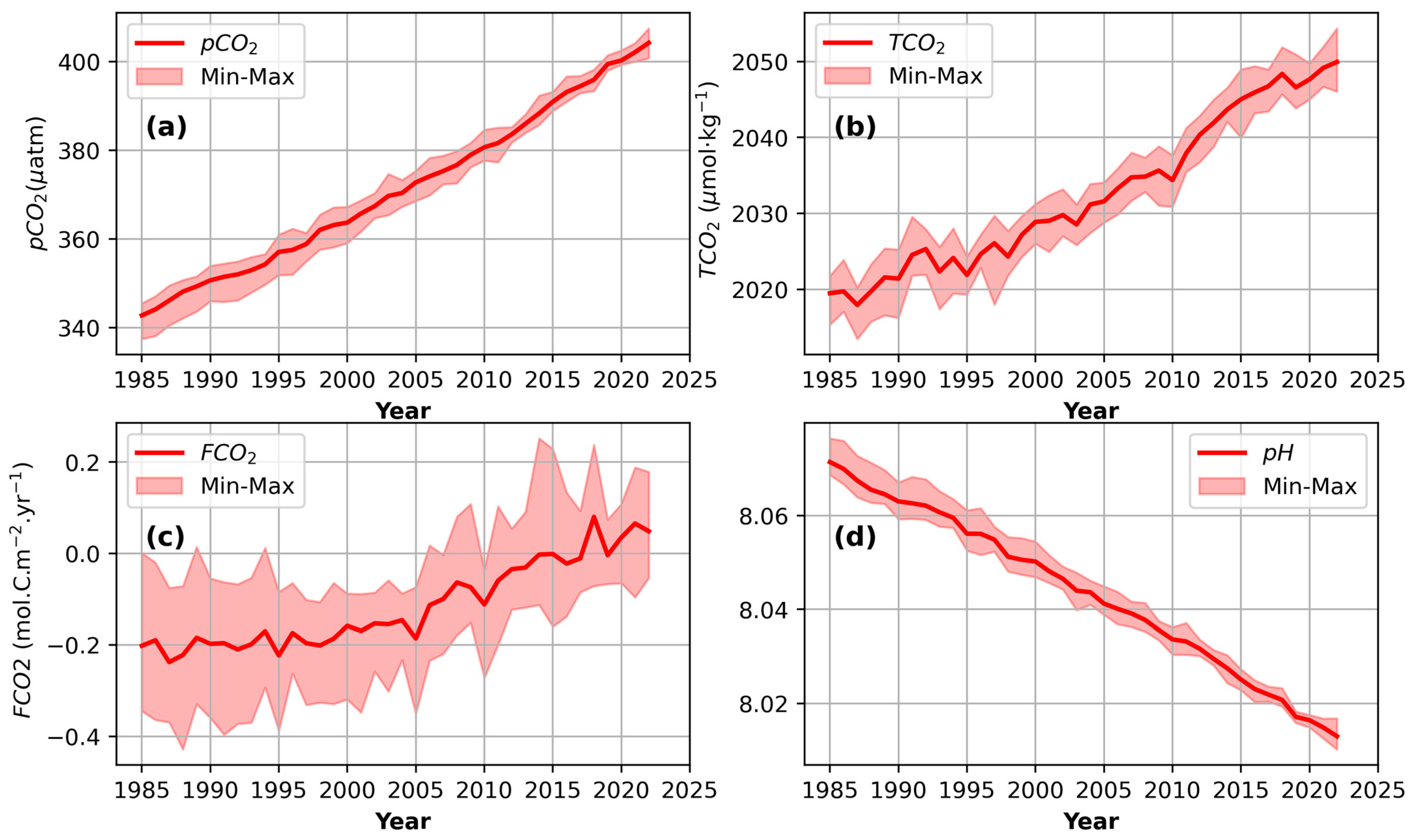

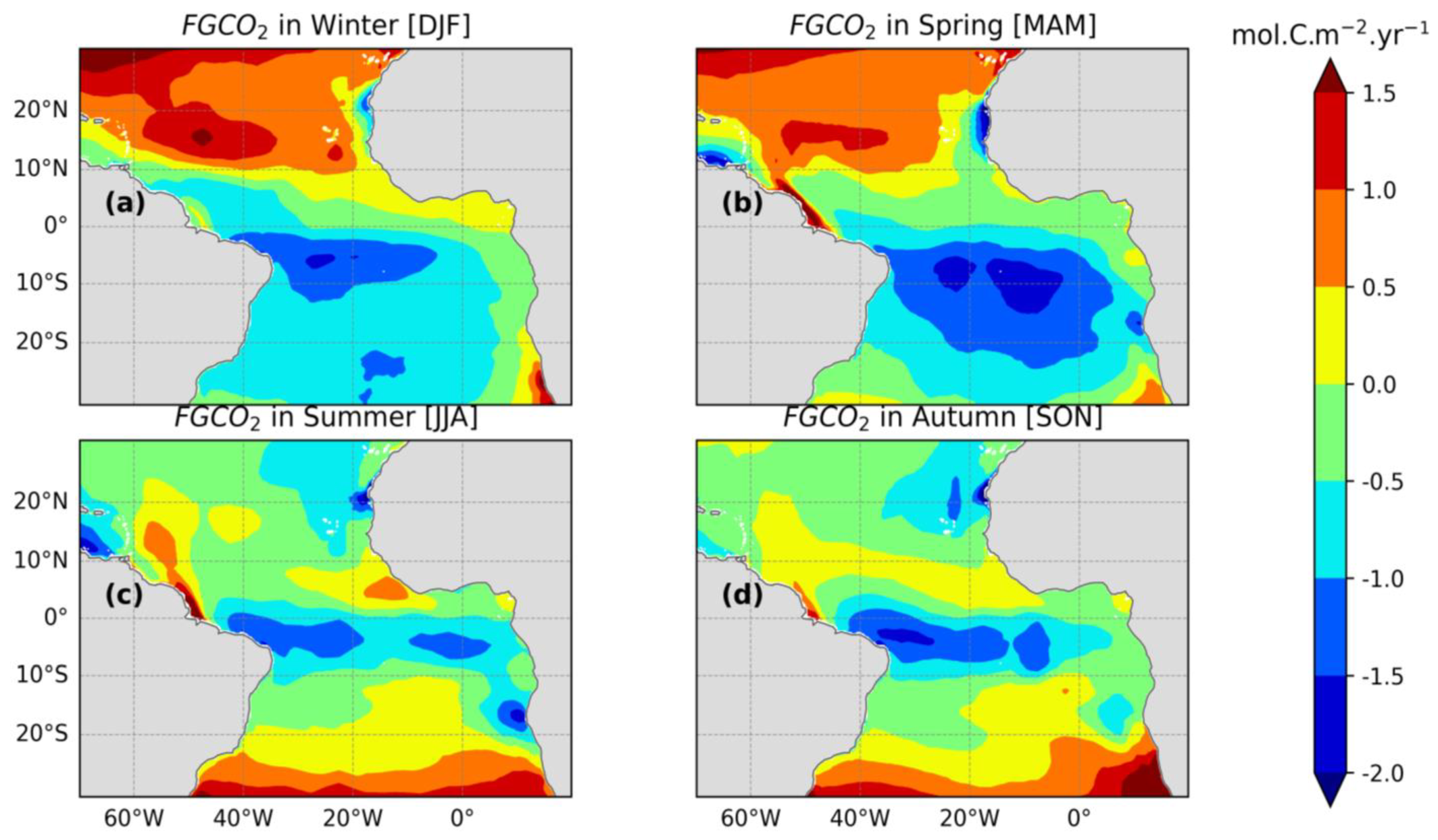

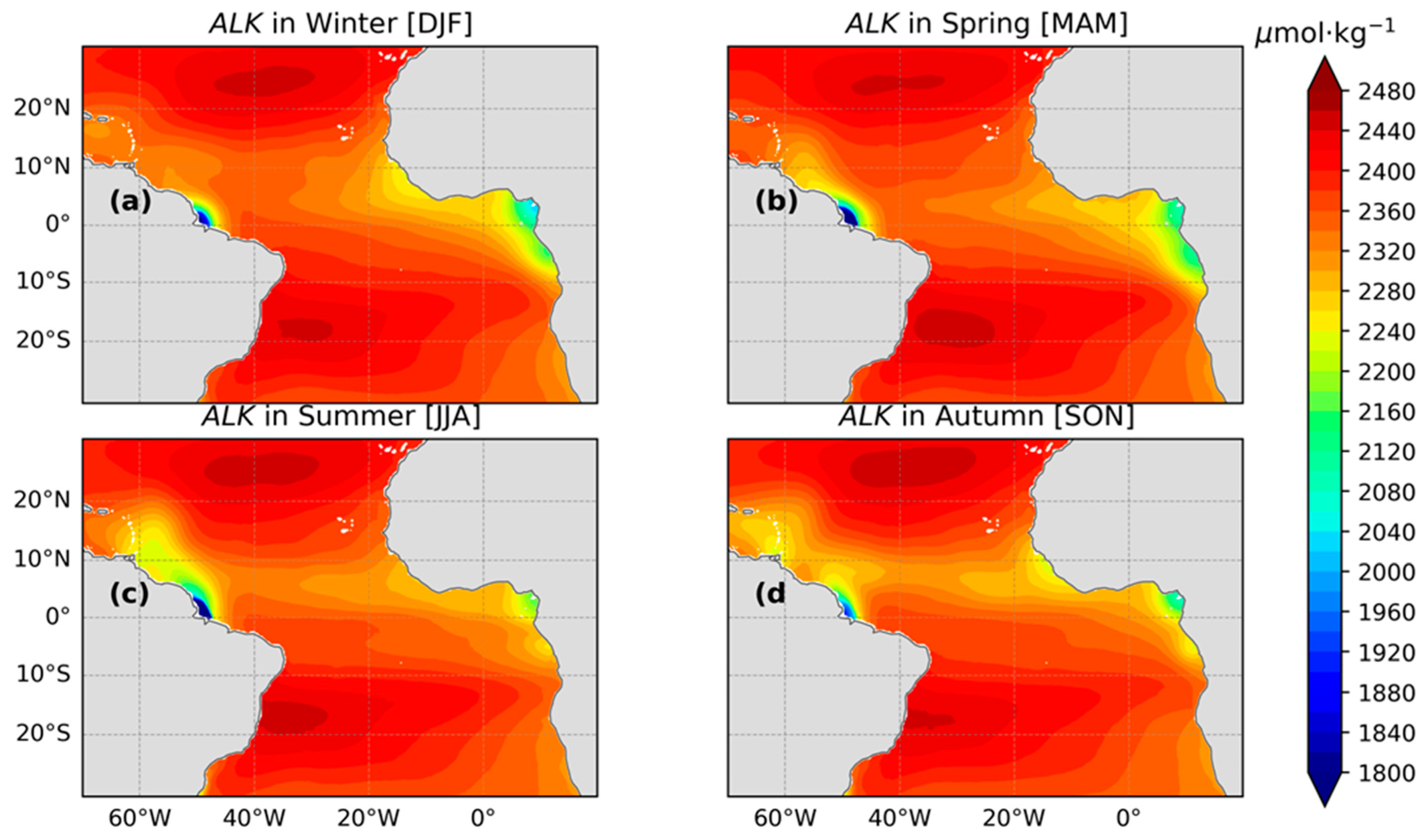
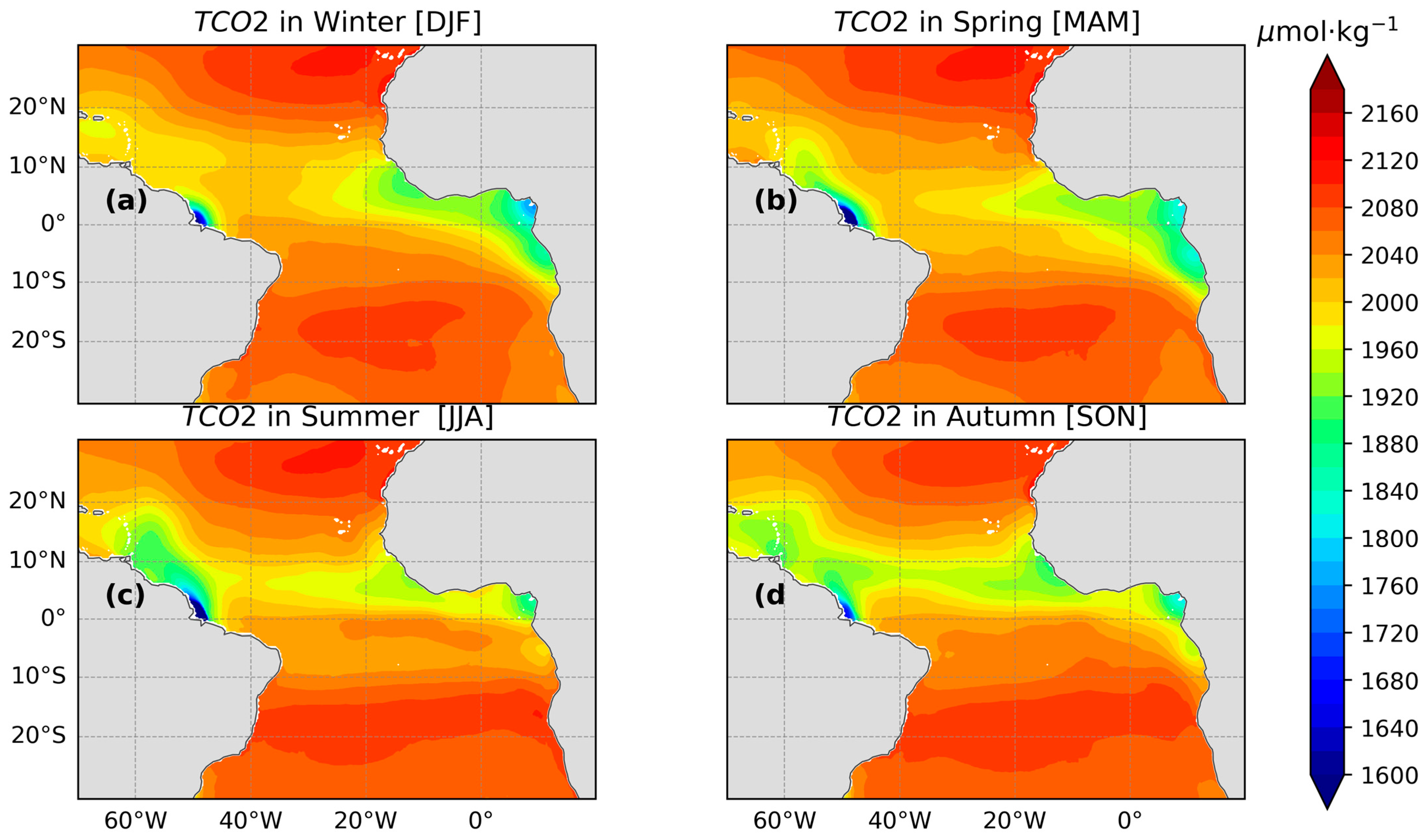
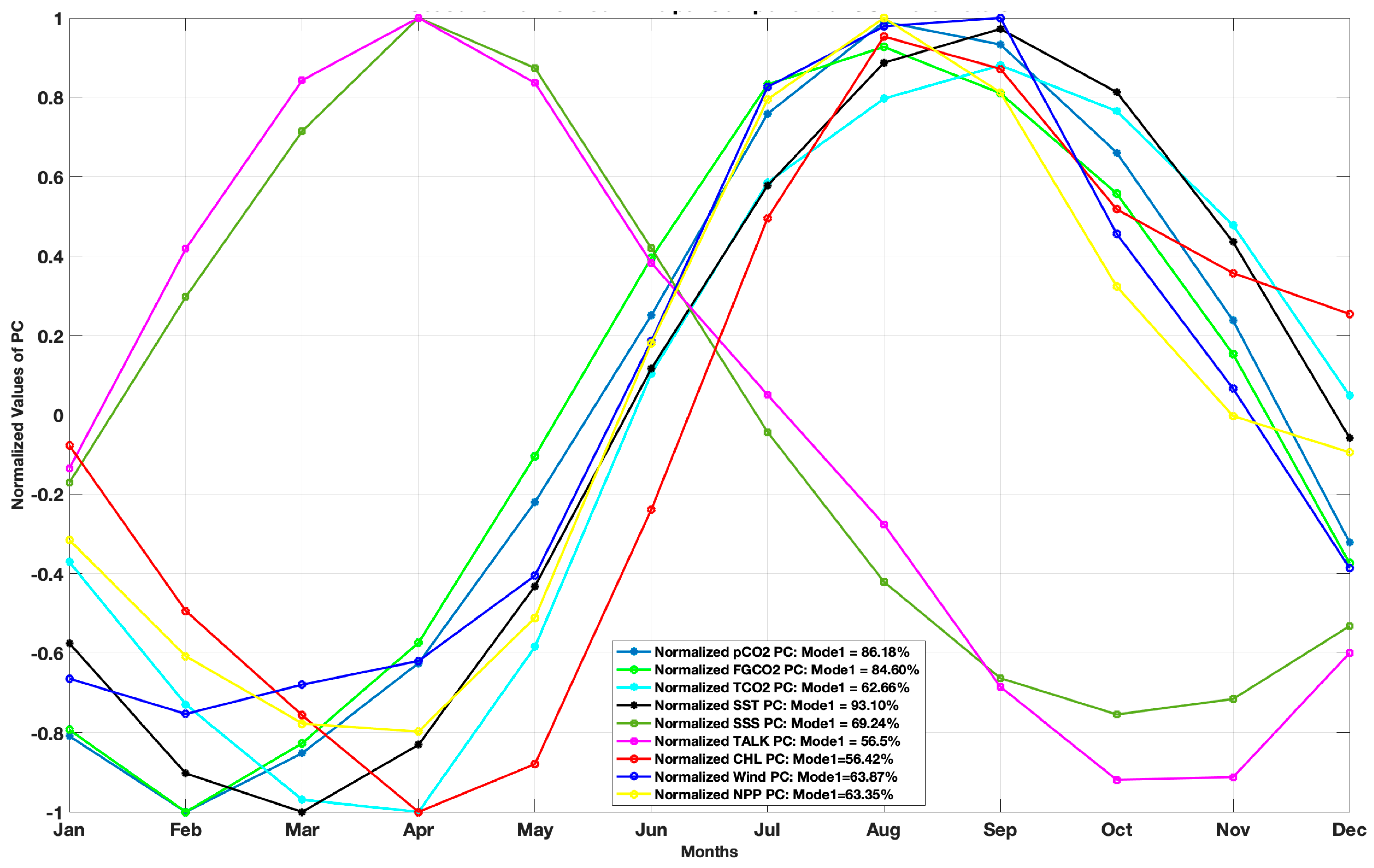
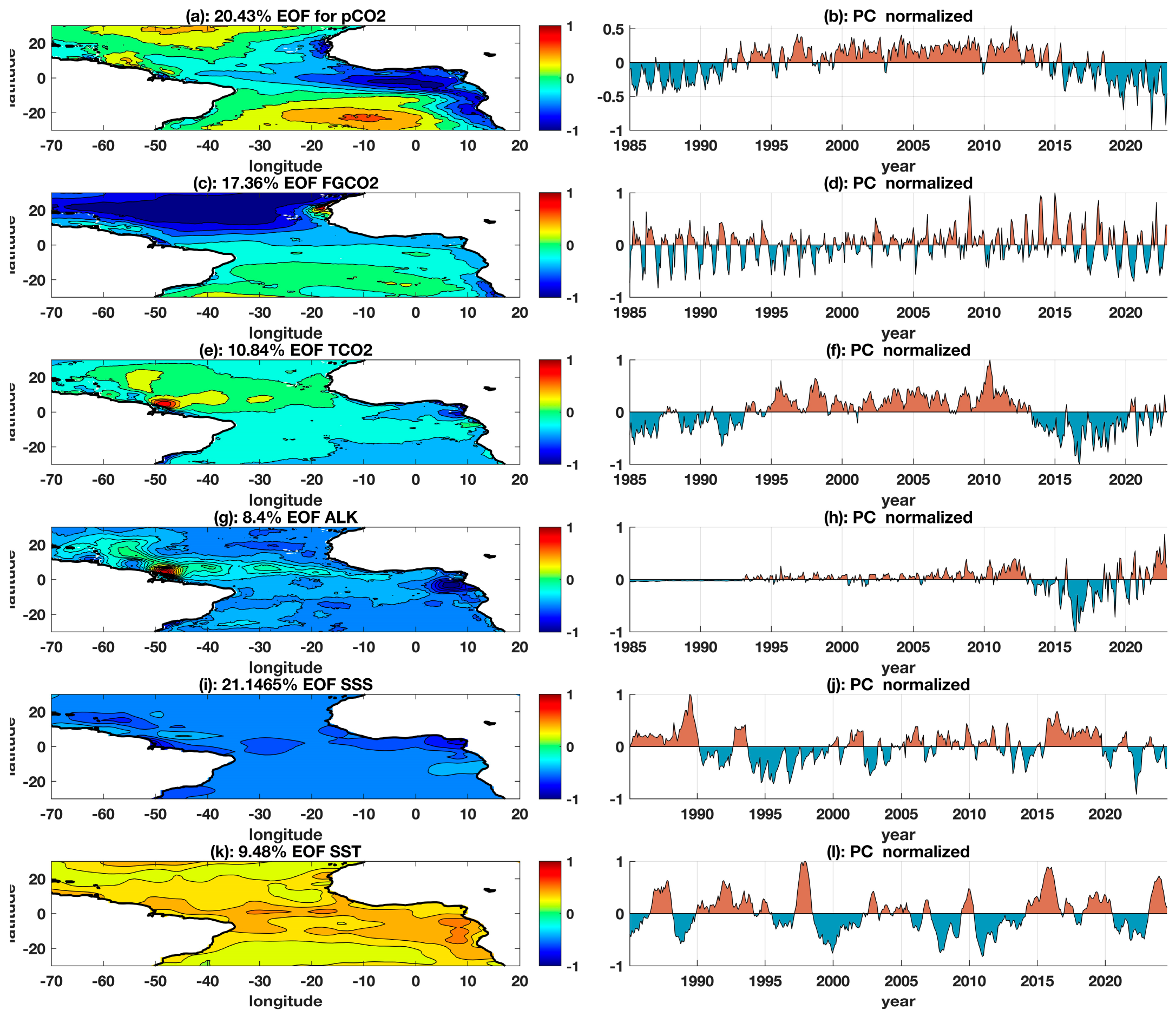

Disclaimer/Publisher’s Note: The statements, opinions and data contained in all publications are solely those of the individual author(s) and contributor(s) and not of MDPI and/or the editor(s). MDPI and/or the editor(s) disclaim responsibility for any injury to people or property resulting from any ideas, methods, instructions or products referred to in the content. |
© 2024 by the authors. Licensee MDPI, Basel, Switzerland. This article is an open access article distributed under the terms and conditions of the Creative Commons Attribution (CC BY) license (https://creativecommons.org/licenses/by/4.0/).
Share and Cite
Bonou, F.; Dossa, A.N.; Dahunsi, A.M.; Sohou, Z. Interannual and Seasonal Variability of CO2 Parameters in the Tropical Atlantic Ocean. J. Mar. Sci. Eng. 2024, 12, 2248. https://doi.org/10.3390/jmse12122248
Bonou F, Dossa AN, Dahunsi AM, Sohou Z. Interannual and Seasonal Variability of CO2 Parameters in the Tropical Atlantic Ocean. Journal of Marine Science and Engineering. 2024; 12(12):2248. https://doi.org/10.3390/jmse12122248
Chicago/Turabian StyleBonou, Frederic, A. Nathanael Dossa, Adeola M. Dahunsi, and Zacharie Sohou. 2024. "Interannual and Seasonal Variability of CO2 Parameters in the Tropical Atlantic Ocean" Journal of Marine Science and Engineering 12, no. 12: 2248. https://doi.org/10.3390/jmse12122248
APA StyleBonou, F., Dossa, A. N., Dahunsi, A. M., & Sohou, Z. (2024). Interannual and Seasonal Variability of CO2 Parameters in the Tropical Atlantic Ocean. Journal of Marine Science and Engineering, 12(12), 2248. https://doi.org/10.3390/jmse12122248





